Comparative Analysis for the Urban Metabolic Differences of Two Types of Cities in the Resource-Dependent Region Based on Emergy Theory
Abstract
:1. Introduction
2. Materials and Methods
2.1. Research Area
2.2. Data Source
2.3. Emergy Analysis
- (1)
- Analyze the main ingredients and energy flows of the urban metabolism of the research area, and establish a basic database consisting of the natural environment, agriculture, industry, and other economic and social sectors.
- (2)
- Make an emergy analysis diagram and define the system boundary, make a list of input sources and output sources, and then calculate the emergy value in terms of solar emjoules (sej) by the process of conversion. The conversion equation is as follows:
- (3)
3. Results
3.1. Metabolic Emergy Structure
3.2. Metabolic Intensity
3.3. Metabolic Pressure
3.4. Metabolic Efficiency
4. Discussion
5. Conclusions and Policy Implications
Acknowledgments
Author Contributions
Conflicts of Interest
References
- Wu, X.J.; Xue, H.F. Complexity Theory and Its Application in Urban System Research; Northwestern Polytechnical University Press: Xi’an, China, 2007; pp. 4–5. [Google Scholar]
- Wu, Y.Q.; Yan, M.; Xu, L.F. Review on the research of emergy-based urban metabolism. Ecol. Environ. Sci. 2009, 18, 1139–1145. [Google Scholar]
- Wolman, A. The metabolism of cities. Sci. Am. 1965, 213, 179–190. [Google Scholar] [CrossRef] [PubMed]
- Kennedy, C.; Cuddihy, J.; Engel-Yan, J. The Changing Metabolism of Cities. J. Ind. Ecol. 2007, 11, 43–59. [Google Scholar] [CrossRef]
- Kennedy, C.; Pincetl, S.; Bunje, P. The study of urban metabolism and its applications to urban planning and design. Environ. Pollut. 2011, 159, 1965–1973. [Google Scholar] [CrossRef] [PubMed]
- Chrysoulakis, N.; Lopes, M.; San José, R.; Grimmond, C.S.B.; Jones, M.B.; Magliulo, V.; Klostermann, J.E.M.; Synnefa, A.; Mitraka, Z.; Vogt, R.; et al. Sustainable urban metabolism as a link between bio-physical sciences and urban planning: The BRIDGE project. Landsc. Urban Plan. 2013, 112, 100–117. [Google Scholar] [CrossRef]
- Zhang, Y.; Liu, H.; Chen, B.; Zheng, H.M.; Li, Y.T. Analysis of urban metabolic processes based on input-output method: Model development and a case study for Beijing. Front. Earth Sci. 2014, 8, 190–201. [Google Scholar] [CrossRef]
- Huang, S.L.; Hsu, W.L. Materials flow analysis and emergy evaluation of Taipei’s urban construction. Landsc. Urban Plan. 2003, 63, 61–74. [Google Scholar] [CrossRef]
- Ascione, M.; Campanella, L.; Chrerubini, F.; Ulgiati, S. Environmental driving forces of urban growth and development: An emergy-based assessment of the city of Rome, Italy. Landsc. Urban Plan. 2009, 93, 238–249. [Google Scholar] [CrossRef]
- Conke, L.S.; Ferreira, T.L. Urban metabolism: Measuring the city’s contribution to sustainable development. Environ. Pollut. 2015, 202, 146–152. [Google Scholar] [CrossRef] [PubMed]
- Liang, S.; Zhang, T. Urban Metabolism in China Achieving Dematerialization and Decarbonization in Suzhou. J. Ind. Ecol. 2011, 15, 420–434. [Google Scholar] [CrossRef]
- Yang, D.; Kao, W.T.M.; Zhang, G.; Zhang, N. Evaluating spatiotemporal differences and sustainability of Xiamen urban metabolism using emergy synthesis. Ecol. Model. 2014, 272, 40–48. [Google Scholar] [CrossRef]
- Pulselli, R.M.; Pulselli, F.M.; Rustici, M. Emergy accounting of the Province of Siena: Towards a thermodynamic geography for regional studies. J. Environ. Manag. 2008, 86, 342–353. [Google Scholar] [CrossRef] [PubMed]
- Li, J.L.; Cao, M.M. Evaluation on development level of circular economy of resource-based city with the Emergy Theory: A case of Yulin city. Arid Land Geogr. 2013, 36, 528–535. [Google Scholar]
- Bian, L.L.; Han, Q.; Zhang, A.H. Emergy-based eco-efficiency evaluation of coal mining area. J. China Coal. Soc. 2013, 38, 549–556. [Google Scholar]
- Sun, Y.F.; Guo, Q.Y. Ecological efficiency analysis of the circular economy system in mining area based on emergy analytic approach. Acta Ecol. Sin. 2014, 34, 710–717. [Google Scholar]
- Cao, Z.G.; Zhao, Y.Q.; Yuan, F.; Li, C.P. Analysis on Development Degree of Mining Cities of China Based on Emergy Theory. China Popul. Resour. Environ. 2010, 20, 56–61. [Google Scholar]
- Huang, Y.; Dong, S.; Li, Z. Urban metabolism evaluation of resource-based cities using emergy synthesis: A case study in Shizuishan City. Resour. Sci. 2015, 37, 1621–1628. [Google Scholar]
- Song, T.; Cai, J.; Ni, P.; Du, S.; Ding, Y. Review and prospects of urban metabolism research. Prog. Geogr. 2013, 32, 1650–1661. [Google Scholar]
- Joseph, M. Local labor market impacts of energy boom-bust-boom in Western Canada. J. Urban Econ. 2012, 71, 165–174. [Google Scholar]
- Patrik, S.; Nanna, S. Mining, regional development and benefit-sharing in developed countries. Resour. Policy 2015, 45, 78–91. [Google Scholar]
- Guo, C.Z.; Luo, L.L.; Ye, M. Empirical analysis of factors the sustainable development of resource-based cities. China Popul. Resour. Environ. 2014, 24, 81–89. [Google Scholar]
- Ding, L.; Shi, Z.L. Economic transition of resource dependent cities-A case study of Taiyuan. J. Tsinghua Univ. 2000, 15, 52–57. [Google Scholar]
- Tang, D.L.; Wang, C.C.; Nie, J.S.; Chen, R.J.; Niu, Q.; Kan, H.D.; Chen, B.H.; Perera, F. Health benefits of improving air quality in Taiyuan, China. Environ. Int. 2014, 73, 235–242. [Google Scholar] [CrossRef] [PubMed]
- Taiyuan Bureau of Statistics. Taiyuan Statistics Yearbook, 2007–2015; China Statistics Press: Beijing, China, 2007–2015. (In Chinese)
- Jincheng Bureau of Statistics. Jincheng Statistics Yearbook, 2007–2015; China Statistics Press: Beijing, China, 2007–2015. (In Chinese)
- Odum, H.T.; Odum, E.C. A Prosperous Way Down; University Press of Colorado: Boulder, CO, USA, 2001; pp. 89–130. [Google Scholar]
- Tilley, D.R.; Swank, W.T. Emergy-based environmental systems assessment of a multi-purpose temperate mixed-forest watershed of the southern Appalachian Mountains, USA. J. Environ. Manag. 2003, 69, 213–227. [Google Scholar] [CrossRef]
- Mellino, S.; Ulgiati, S. Mapping the evolution of impervious surfaces to investigate landscape metabolism: An Emergy-GIS monitoring application. Ecol. Inform. 2014, 26, 50–59. [Google Scholar] [CrossRef]
- Huang, Q.; Zheng, X.; Hu, Y. Analysis of Land-Use Emergy Indicators Based on Urban Metabolism: A Case Study for Beijing. Sustainability 2015, 7, 7473–7491. [Google Scholar] [CrossRef]
- Liu, G.Y.; Yang, Z.F.; Chen, B.; Zhang, Y.; Zhang, L.X.; Zhao, Y.W.; Jiang, M.M. Emergy-based urban ecosystem health assessment: A case study of Baotou, China. Commun. Nonlinear Sci. Numer. Simul. 2009, 14, 972–981. [Google Scholar] [CrossRef]
- Liu, G.Y.; Yang, Z.F.; Chen, B.; Ulgiati, S. Emergy-based urban health evaluation and development pattern analysis. Ecol. Model. 2009, 220, 2291–2301. [Google Scholar] [CrossRef]
- Li, D.; Liu, J.R.; Wang, R.S. Progresses on the Analyzing Methods and Evaluating Indicators of Urban Ecosystems Metabolism. Ecol. Econ. 2008, 6, 35–39. [Google Scholar]
- Odum, H.T. Environmental Accounting: Energy and Environmental Decision Making; John Wiley and Sons Inc.: New York, NY, USA, 1996. [Google Scholar]
- Odum, H.T.; Brown, M.T.; Brandt-Williams, S.B. Handbook of Emergy Evaluation: A Compendium of Data for Emergy Computation Issued in a Series of Folios; Center for Environmental Policy, University of Florida: Gainesville, FL, USA, 2000. [Google Scholar]
- Brown, M.T.; Ulgiati, S. Emergy evaluations and environmental loading of electricity production systems. J. Clean. Prod. 2002, 10, 321–334. [Google Scholar] [CrossRef]
- Song, T.; Cai, J.M.; Du, S.S.; Ni, P.; Ding, Y. Emergy analysis of urban metabolism in Beijing. J. Arid Land Resour. Environ. 2015, 29, 37–42. [Google Scholar]
- Brown, M.T.; Ulgiati, S. Emergy-based indices and ratios to evaluate sustainability: Monitoring economies and technology toward environmentally sound innovation. Ecol. Eng. 1997, 9, 51–69. [Google Scholar] [CrossRef]
- Liu, C.; Shi, X.Y.; Gao, Q. Environmental impact dynamic tracking assessment of land use planning based on entropy weight and matter element model. Acta Sci. Circum. 2014, 35, 2641–2647. [Google Scholar]
- Lei, K.; Hu, D.; Zhou, S.; Zhen, G. Monitoring the sustainability and equity of socioeconomic development: A comparison of emergy indices using Macao, Italy and Sweden as examples. Acta Ecol. Sin. 2012, 32, 165–173. [Google Scholar] [CrossRef]
- Wu, Y.; Yan, M. Simulation Analysis of Urban Metabolic Efficiency in Guangzhou City. Resour. Sci. 2011, 33, 1555–1562. [Google Scholar]
- Zhang, Y.; Yang, Z. Emergy Analysis of Urban Material Metabolism and Evaluation of Eco-Efficiency in Beijing. Acta Sci. Circum. 2007, 27, 1892–1899. [Google Scholar]
- González, A.; Donnelly, A.; Jones, M.; Chrysoulakis, N.; Lopes, M. A Decision-Support System for sustainable urban metabolism in Europe. Environ. Impact Assess. Rev. 2013, 38, 109–119. [Google Scholar] [CrossRef]
- Song, T.; Cai, J.M.; Ni, P.; Yang, Z.S. The Chinese urban metabolisms based on the emergy theory. Chin. J. Appl. Ecol. 2014, 25, 1085–1092. [Google Scholar]
- Zhang, J.J.; Fu, M.C.; Geng, Y.; Tao, J. Energy saving and emission reduction: A project of coal-resource integration in Shanxi Province, China. Energy Policy 2011, 39, 3029–3032. [Google Scholar] [CrossRef]
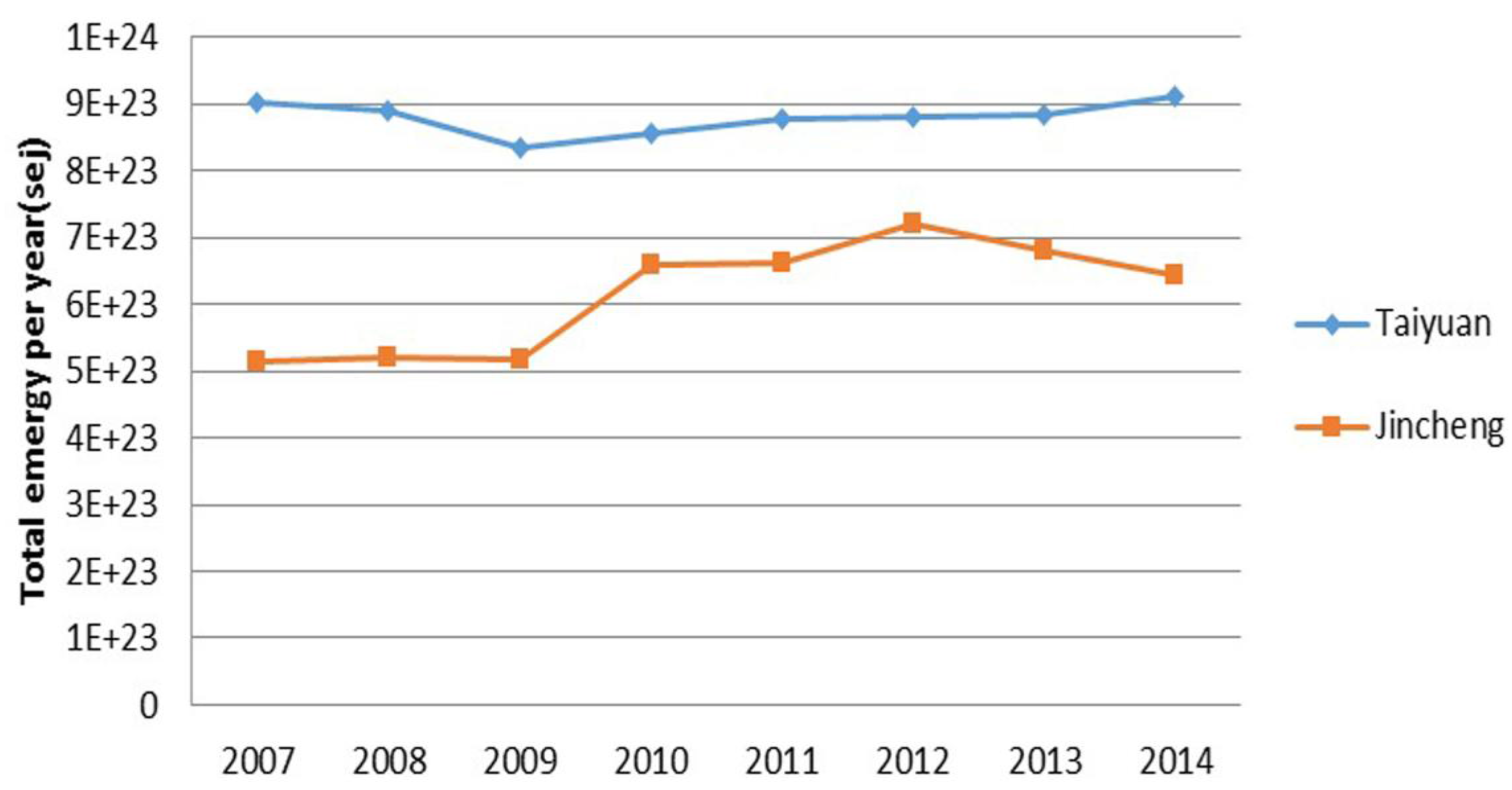
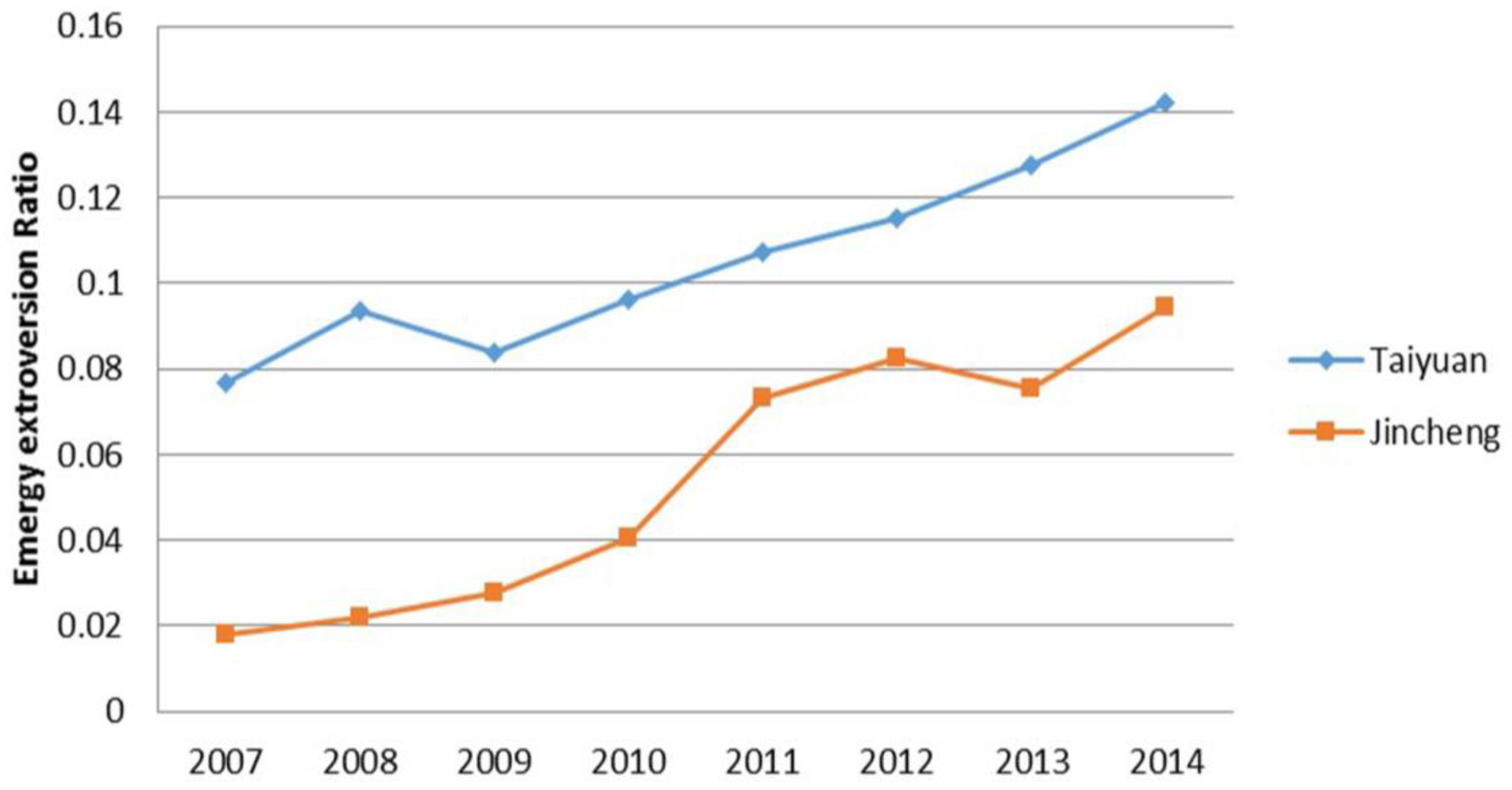
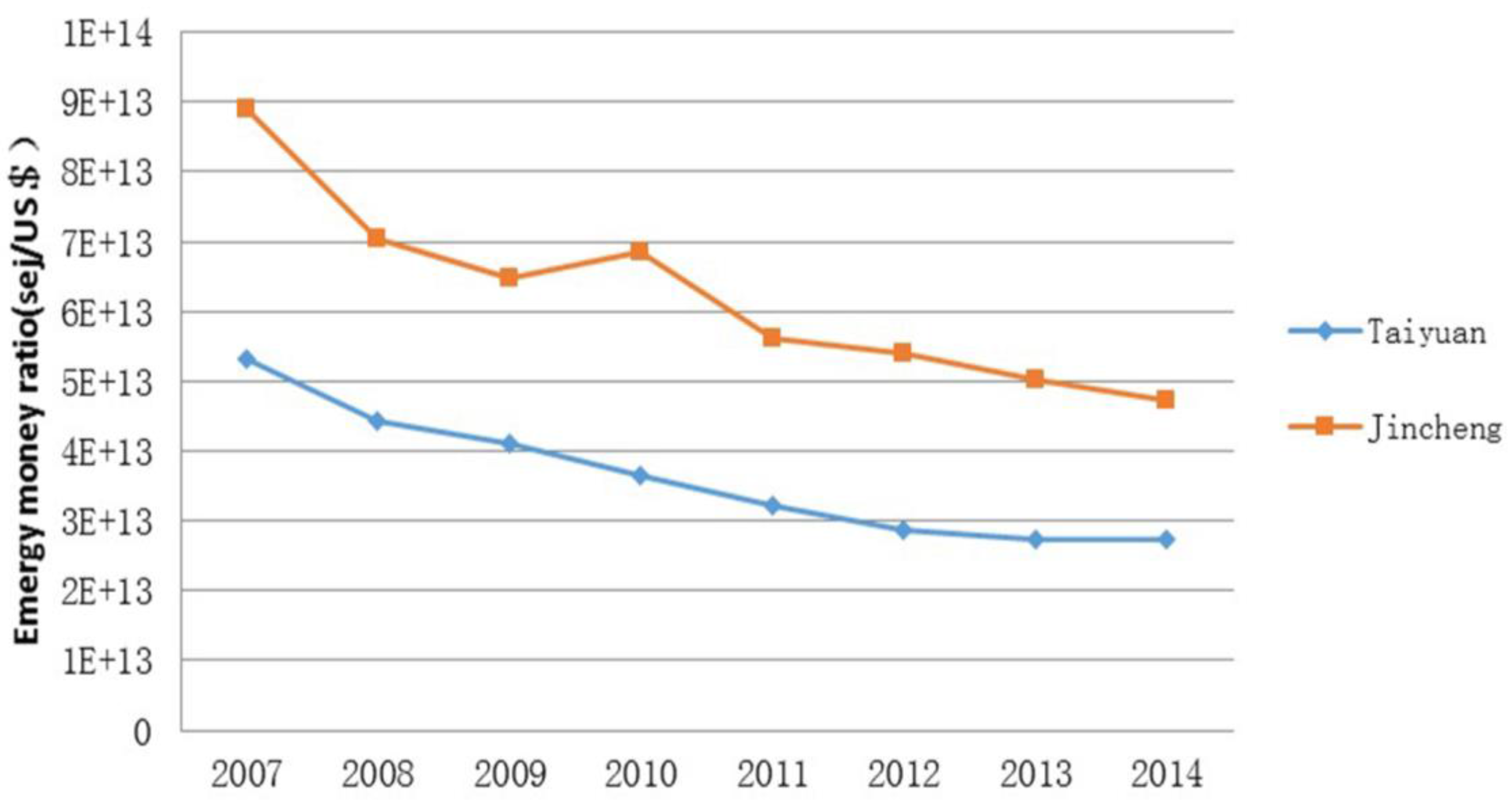
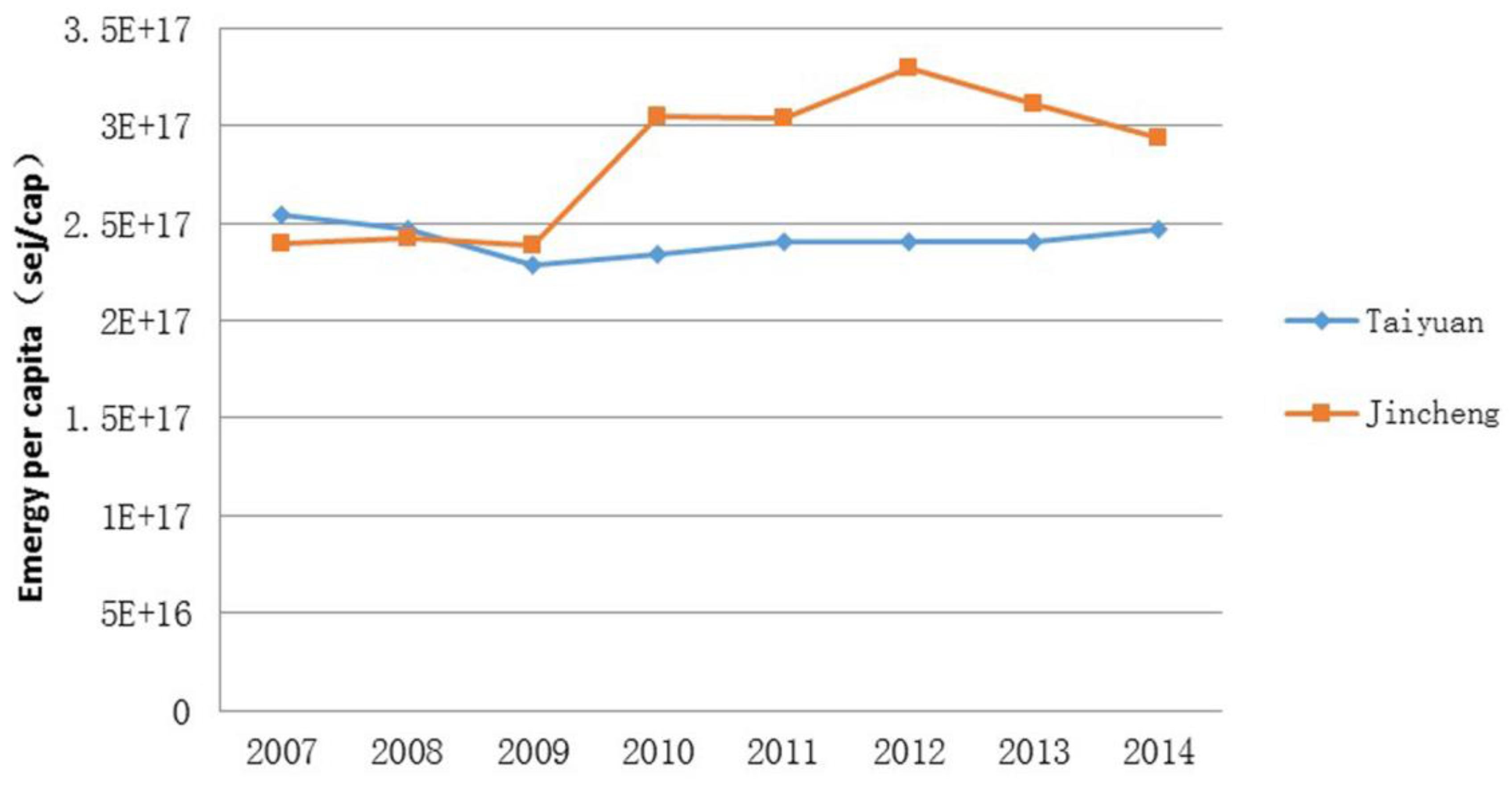
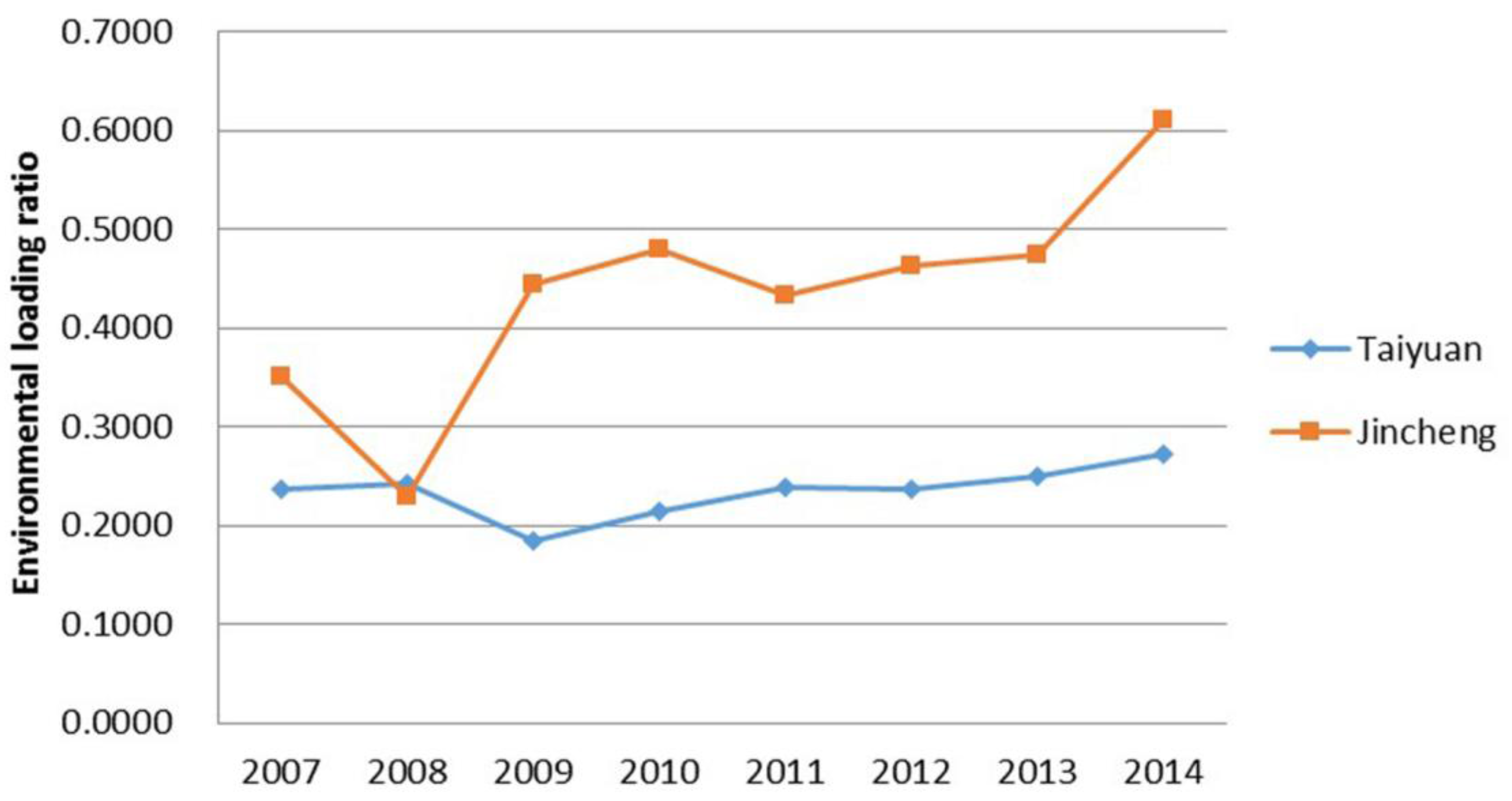
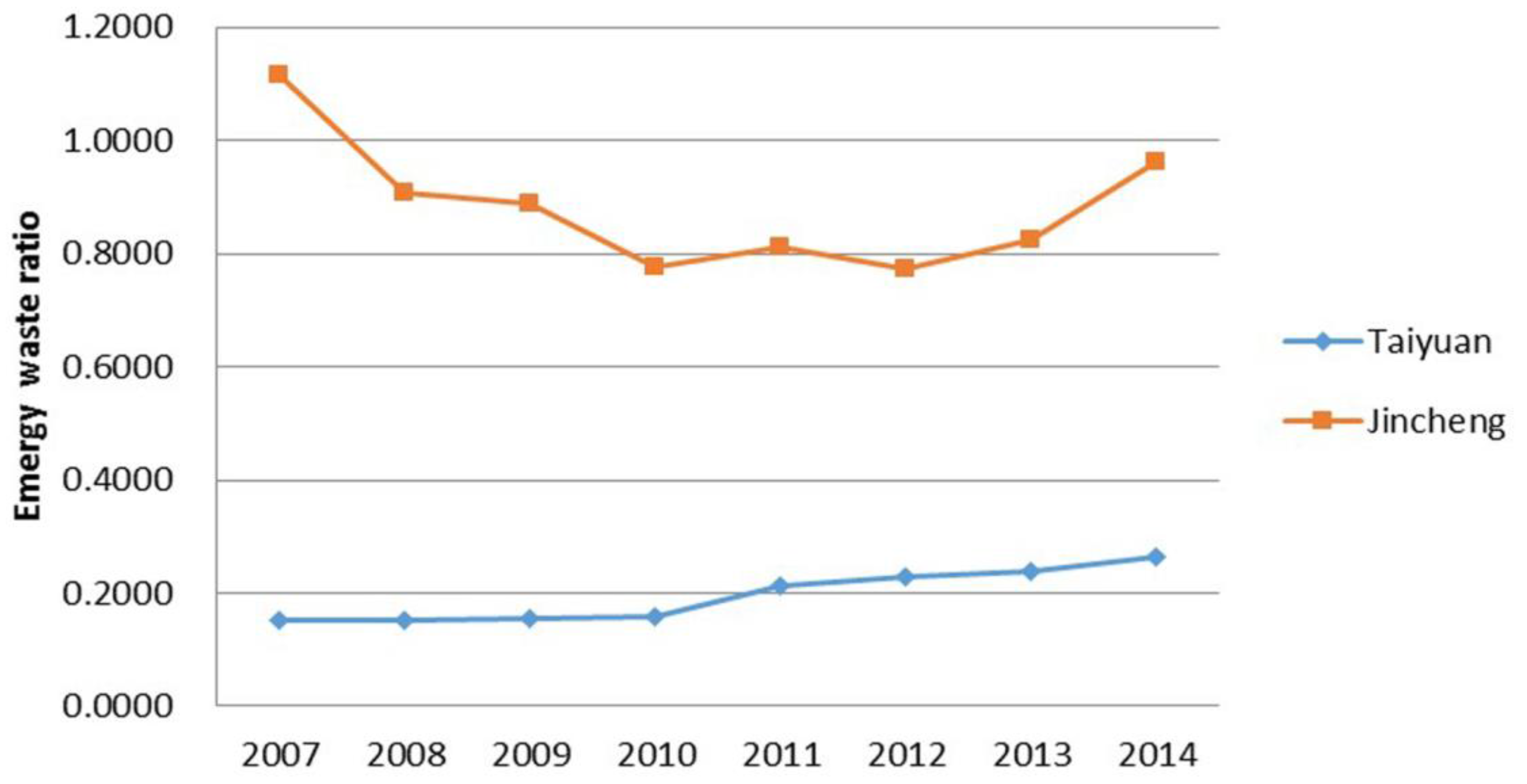
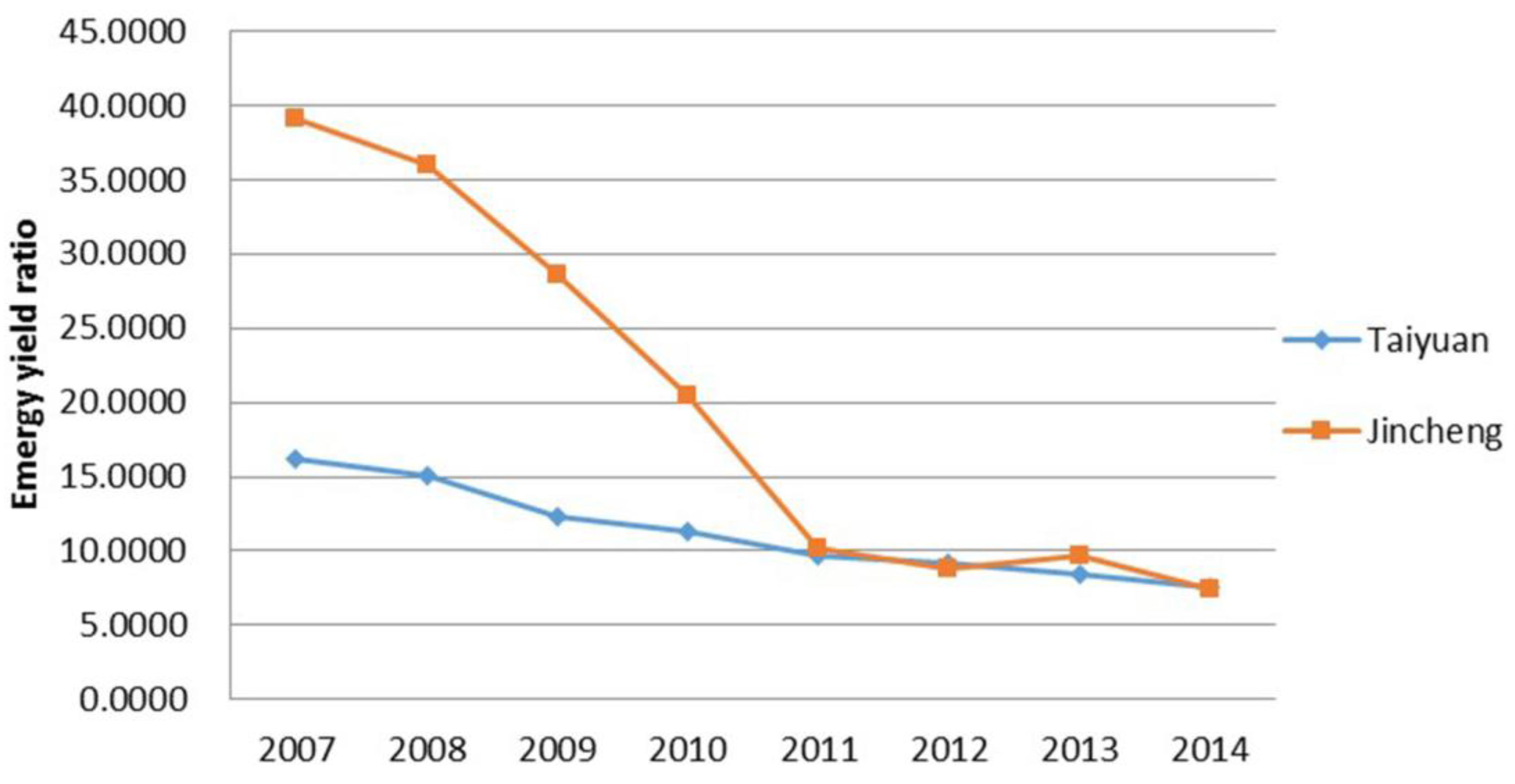

| Emergy Category | Item | Unit | Tranformity (sej/J) | Reference |
|---|---|---|---|---|
| Renewable resource emergy (R) | Solar energy | J | 1 | [34] |
| Wind Energy | J | 2.45 × 103 | [35] | |
| Rainfall energy(chemical) | J | 3.05 × 104 | [35] | |
| Rainfall energy(geo-potential) | J | 4.70 × 104 | [35] | |
| Earth cycle energy | J | 5.80 × 104 | [35] | |
| Agricultural products | g | 4.08 × 1011 | [34] | |
| Livestock | g | 2.50 × 1011 | [34] | |
| Aquatic products | g | 3.02 × 1010 | [34] | |
| Non-renewable resource emergy (N) | Losses of topsoil | t | 1.71 × 103 | [35] |
| Electricity | J | 2.69 × 105 | [34] | |
| Steel | g | 3.02 × 109 | [34] | |
| Raw coal | J | 6.72 × 104 | [34] | |
| Petroleum | J | 1.86 × 105 | [34] | |
| Diesel | J | 1.86 × 105 | [34] | |
| Natural gas | J | 8.06 × 104 | [34] | |
| Fuel oil | J | 6.25 × 104 | [35] | |
| Chemical fertilizer | t | 8.28 × 106 | [36] | |
| Imported emergy (IM) | Goods income | $ | 9.37 × 1012 | [35] |
| Toursim income | $ | 1.66 × 1012 | [36] | |
| Exported emergy (EX) | Goods and service income | $ | 6.34 × 1012 | [35] |
| Waste emergy (W) | Solid waste | g | 1.80 × 109 | [8] |
| Waste water | g | 6.66 × 108 | [8] | |
| Waste air | g | 6.66 × 108 | [8] |
| Metabolic Category | Emergy Indicators | Unit | Formula | Explanation |
|---|---|---|---|---|
| Metabolic emergy structure | Total emergy per year (U) | Sej | R+ N + IM | Total emergy (the export and waste are not included) |
| Emergy extroversion ratio (EER) | 1 | (IM + EX)/(U + EX + W) | The dependency degree to the import and export of the urban system | |
| Metabolic intensity | Emergy money ratio (EMR) | sej/yuan | U/GDP | Emergy flux produced per unit of economic output |
| Emergy per capita (EP) | sej/cap | U/Population | Metabolic efficiency per capita | |
| Metabolic pressure | Environmental loading ratio (ELR) | 1 | (N + IM)/R | Metabolic system’s pressure on the environment |
| Emergy waste ratio (EWR) | 1 | W/R | The circulation power of the urban system | |
| Metabolic efficiency | Emergy yield ratio (EYR) | 1 | (R + N + IM)/IM | The capacity of resource output of the urban system |
| Emergy sustainable index (ESI) | 1 | EYR/ELR | The sustainability capacity of the local urban system |
© 2016 by the authors; licensee MDPI, Basel, Switzerland. This article is an open access article distributed under the terms and conditions of the Creative Commons Attribution (CC-BY) license (http://creativecommons.org/licenses/by/4.0/).
Share and Cite
Liu, C.; Shi, X.; Qu, L.; Li, B. Comparative Analysis for the Urban Metabolic Differences of Two Types of Cities in the Resource-Dependent Region Based on Emergy Theory. Sustainability 2016, 8, 635. https://doi.org/10.3390/su8070635
Liu C, Shi X, Qu L, Li B. Comparative Analysis for the Urban Metabolic Differences of Two Types of Cities in the Resource-Dependent Region Based on Emergy Theory. Sustainability. 2016; 8(7):635. https://doi.org/10.3390/su8070635
Chicago/Turabian StyleLiu, Chang, Xueyi Shi, Lulu Qu, and Bingyi Li. 2016. "Comparative Analysis for the Urban Metabolic Differences of Two Types of Cities in the Resource-Dependent Region Based on Emergy Theory" Sustainability 8, no. 7: 635. https://doi.org/10.3390/su8070635





